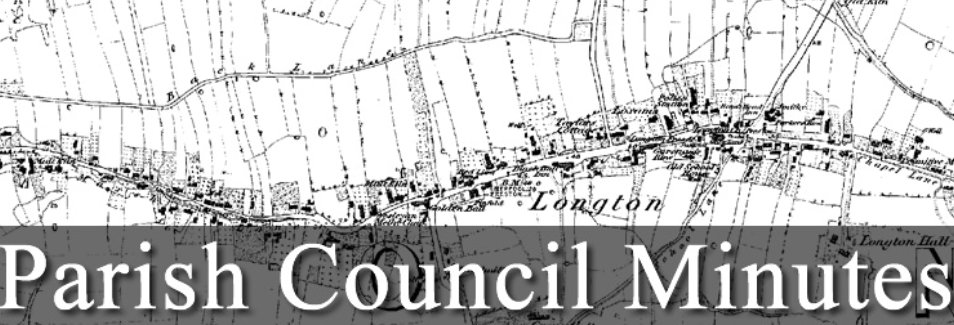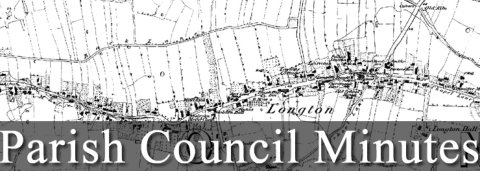




LongtonOnline.co.uk
It is the first tier of Local Government and was created by statute in 1894
Before 1894, for many years, the affairs of the parishes had been administered by a vestry, or meeting of the village inhabitants.
Inevitably these meetings were dominated by the squire, the parson and the principal ratepayers and some became ‘select vestries’, only open to
those people deemed ‘suitable’ to serve.
In many parishes, particularly rural ones, the system worked perfectly well, in others it was virtually non-existent or very inefficient. For a variety
of reasons, including a general movement towards greater ‘democracy’; and a desire to break the power of the Church of England over the lives of
nonconformists and non-believers, a Bill was promoted to create Parish Councils.
After a difficult passage through parliament and many amendments, this Bill became an Act in 1894. Its effect was to transfer all non ecclesiastical
functions from the church to the elected Parish Councils. Some other functions were added, such as those relating to the burial of the dead, which
had, many years before, been vested in Burial Boards, an early form of QUANGO.
The regulations under which the first Parish Councils operated were not very tight at that stage and the influence of the church was not so easily to
be diminished. There were many anomalies and difficulties encountered in the years between 1894 and 1972, when the present basic Local
Government Act came into being. A full and very entertaining account of these years can be found in the above quoted book.
Much has changed since 1894, despite the impression given by the“The Vicar of Dibley” TV series. Parish Councils are closely regulated and the
amount of administrational bureaucracy and red tape has increased exponentially in the past few years, with an accompanying rise in costs of audit
and insurance.
On the other hand, with lines of responsibility more clearly drawn, there now appears to be no general animosity towards the church and some
villages still have the parson on the Parish Council. That is, if s/he has the time to spare, because the church has also changed considerably, with
greatly enlarged parishes, few curates and the same problem with red tape and mountains of post.
Powers and Responsibilities of Parish Councils The Local Government Act, 1972, is the one most often referred to when describing the modern
powers and responsibilities of Parish Councils but it is augmented by many earlier and later Acts, such as The Criminal Justice and Public Order, Act
1994, which, on the face of it, would not appear to relate to Parish Councils but which gave them a long needed ability to pay for measures to
combat crime and the fear of crime in villages.
Parish Councils may only spend public money on projects or actions for which they have a Statutory Power. Breaking this rule is likely to result in a
PC’s accounts being refused by the auditor and, possibly, the individual councillors being required to repay the money illegally expended.
There is still, as there was in 1894, only one power which the Parish Council must consider using and that is to provide allotments for the labouring
poor, if asked for them. All other powers are voluntary - the Parish Council is not obliged to exercise them and indeed the majority would find it
difficult to raise enough money to exercise them all on a permanent basis. Raising the wind Parish Councils are empowered to raise money for their
activities through a tax (the "precept") on the village residents which is collected on their behalf by the District Council, as an addition to the
District and County Council Tax. This is then paid to the Parish Council in two equal instalments. Two neighbouring Parish Councils might require the
same amount of money to function but the fewer houses there are in a village, the more each household is obliged to pay towards raising this sum.
Thus, the actual tax paid by similar houses in neighbouring villages could differ widely. Though not actually ‘capped’ in their expenditure, as are
the Principal Councils, the activities of many smaller Parish Councils are effectively limited by this difficulty; to what, in vulgar parlance, ‘the
market can stand’. To combat this, smaller councils are being encouraged to combine for some large projects and share the expense across a wider
base. Borrowing is allowed, up to a prescribed limit and with permission, but this is of limited help to a small parish because, of course, the loan
(plus interest) has to be repaid from slim resources. Grants may be obtained for specific purposes from various sources, not least the District
Council. Very few, if any of these, can be used for maintenance or general administration purposes. Limited fund raising can be done but this is so
hedged about by restrictions that, in the main, it is hardly worthwhile for a very small council.
What is a Parish Council






It is the first tier of Local Government and was created by statute in
1894
Before 1894, for many years, the affairs of the parishes had been
administered by a vestry, or meeting of the village inhabitants.
Inevitably these meetings were dominated by the squire, the parson
and the principal ratepayers and some became ‘select vestries’, only
open to those people deemed ‘suitable’ to serve.
In many parishes, particularly rural ones, the system worked perfectly
well, in others it was virtually non-existent or very inefficient. For a
variety of reasons, including a general movement towards greater
‘democracy’; and a desire to break the power of the Church of England
over the lives of nonconformists and non-believers, a Bill was promoted
to create Parish Councils.
After a difficult passage through parliament and many amendments,
this Bill became an Act in 1894. Its effect was to transfer all non
ecclesiastical functions from the church to the elected Parish Councils.
Some other functions were added, such as those relating to the burial
of the dead, which had, many years before, been vested in Burial
Boards, an early form of QUANGO.
The regulations under which the first Parish Councils operated were not
very tight at that stage and the influence of the church was not so
easily to be diminished. There were many anomalies and difficulties
encountered in the years between 1894 and 1972, when the present
basic Local Government Act came into being. A full and very
entertaining account of these years can be found in the above quoted
book.
Much has changed since 1894, despite the impression given by the“The
Vicar of Dibley” TV series. Parish Councils are closely regulated and
the amount of administrational bureaucracy and red tape has increased
exponentially in the past few years, with an accompanying rise in costs
of audit and insurance.
On the other hand, with lines of responsibility more clearly drawn,
there now appears to be no general animosity towards the church and
some villages still have the parson on the Parish Council. That is, if
s/he has the time to spare, because the church has also changed
considerably, with greatly enlarged parishes, few curates and the same
problem with red tape and mountains of post.
Powers and Responsibilities of Parish Councils The Local Government
Act, 1972, is the one most often referred to when describing the
modern powers and responsibilities of Parish Councils but it is
augmented by many earlier and later Acts, such as The Criminal Justice
and Public Order, Act 1994, which, on the face of it, would not appear
to relate to Parish Councils but which gave them a long needed ability
to pay for measures to combat crime and the fear of crime in villages.
Parish Councils may only spend public money on projects or actions for
which they have a Statutory Power. Breaking this rule is likely to result
in a PC’s accounts being refused by the auditor and, possibly, the
individual councillors being required to repay the money illegally
expended.
There is still, as there was in 1894, only one power which the Parish
Council must consider using and that is to provide allotments for the
labouring poor, if asked for them. All other powers are voluntary - the
Parish Council is not obliged to exercise them and indeed the majority
would find it difficult to raise enough money to exercise them all on a
permanent basis. Raising the wind Parish Councils are empowered to
raise money for their activities through a tax (the "precept") on the
village residents which is collected on their behalf by the District
Council, as an addition to the District and County Council Tax. This is
then paid to the Parish Council in two equal instalments. Two
neighbouring Parish Councils might require the same amount of money
to function but the fewer houses there are in a village, the more each
household is obliged to pay towards raising this sum. Thus, the actual
tax paid by similar houses in neighbouring villages could differ widely.
Though not actually ‘capped’ in their expenditure, as are the Principal
Councils, the activities of many smaller Parish Councils are effectively
limited by this difficulty; to what, in vulgar parlance, ‘the market can
stand’. To combat this, smaller councils are being encouraged to
combine for some large projects and share the expense across a wider
base. Borrowing is allowed, up to a prescribed limit and with
permission, but this is of limited help to a small parish because, of
course, the loan (plus interest) has to be repaid from slim resources.
Grants may be obtained for specific purposes from various sources, not
least the District Council. Very few, if any of these, can be used for
maintenance or general administration purposes. Limited fund raising
can be done but this is so hedged about by restrictions that, in the
main, it is hardly worthwhile for a very small council.
What is a Parish Council

LongtonOnline.co.uk



















































